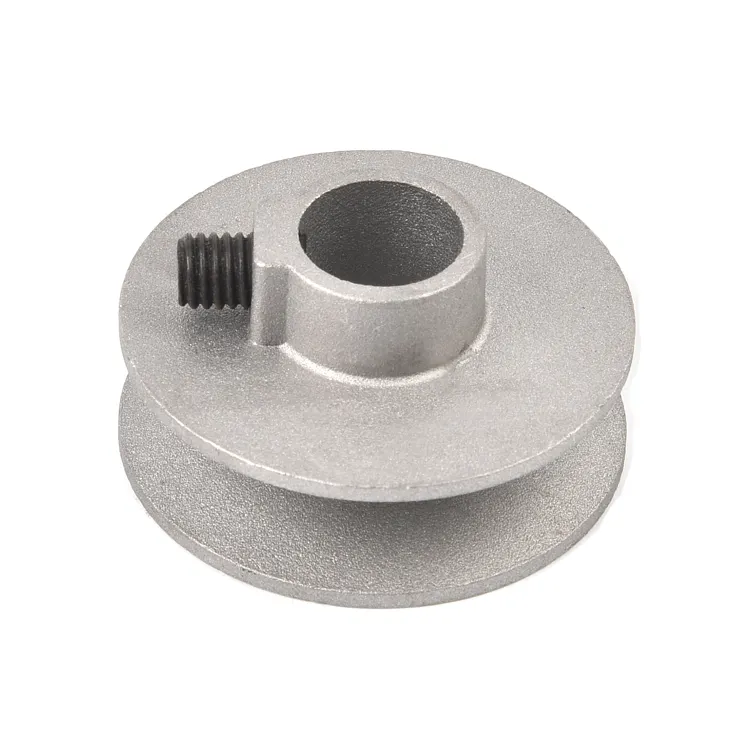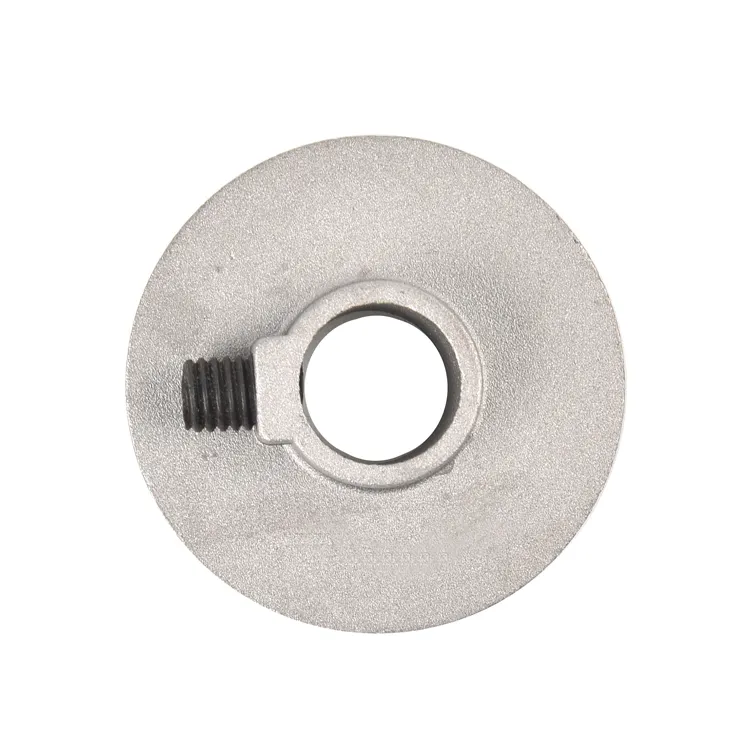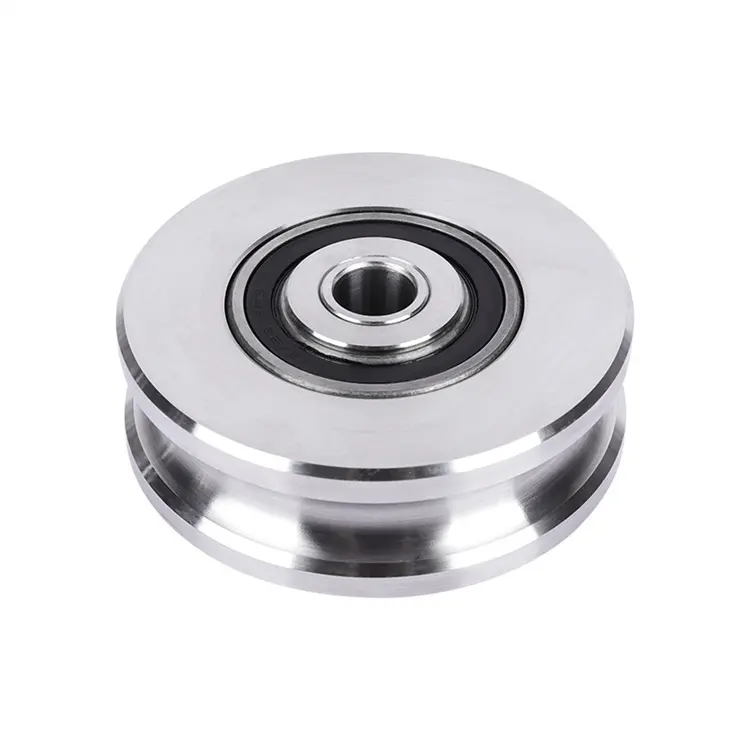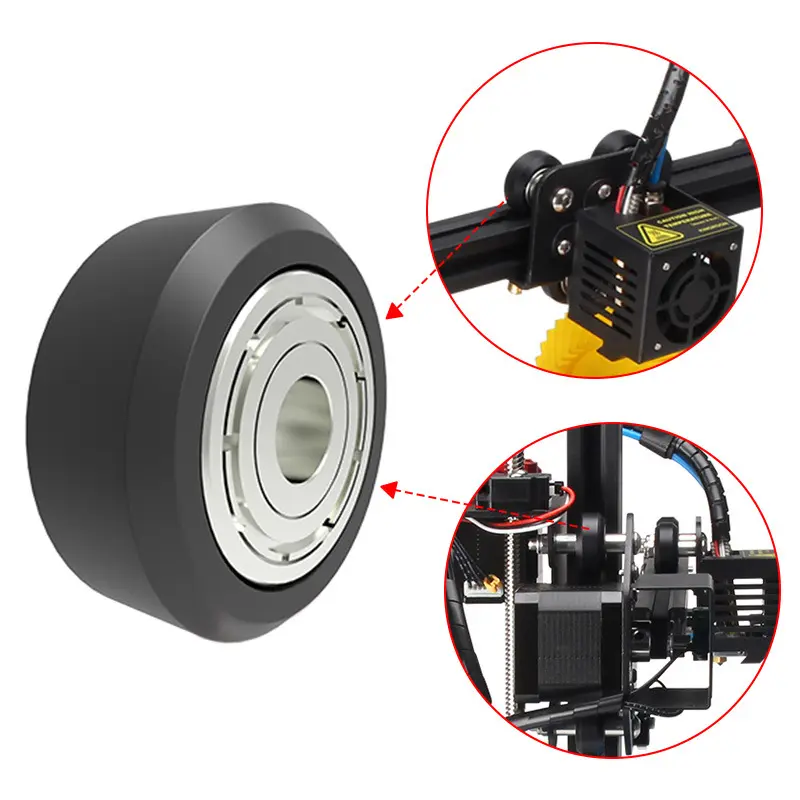Product Description
Excellent OEM V Belt Aluminum Keyway Pulley Air Condition Fixed Pulley
Why Choose us
1. Own mould R&D team and mould making workshop.
2. Own factory to offer the reasonable prices and quick response.
3. Complete service from mould, production, heat treatment, surface treatment, assemble.
4. 20years experience for die casting.
5. Squeeze casting+T6 — to make the parts with lightweight and strong strength.
| Process | Aluminum Die casting, Squeeze casting+T6, Zinc Alloy die casting,CNC machining, Turning |
| Equipment | Cold chamber die casting machine:200T/280T/400T/600T/800T/1100T.CNC centers, CNC turning, CNC lathes, electrical pulse, line cutting, milling, drilling, grinding |
| Material | A319, A356, A360, A369, A380, A383, A384, A413, A535, 44300, 44300, 46000, AlSi9Mg, AlSi9Cu3, ADC12, ZL102, ZL104, ZL108, Zamak2,3,5,7 ect. Squeeze Casting: A356+T6, A356.2+T6, AlSi9Mg+T6, Zl108+T6, AlTi-Alloy+T6 |
| Surface | Trimming, Deburring,Polishing, Shot blasting, Sand blasting,Tumbling, Powder coating, Anodizing, Chrome, Zinc, Electrophoresis, Passivation, Chemical coating. |
| Software Assistance | Pro-e/Solid work/UG/Auto CAD/CATIA |
| Products Application | Automotive industry, Bicycle and motorcycle, Door and windows and furniture, Household appliance, Gas meter, Power tool,LED lighting, Medical instrument parts, ect. |
As a manufacturer, it is a great advantage to have our own moulds workshop, to make the perfect parts by saving time and costs. Set with full machines and skilled team, we can finish moulds very quickly for some big project with more than 50 models of parts. And changing or testing new samples always are free to customer and to be finished within short time.
Full equipments support us the enough production capacity. We can make a wide range of parts from 0.01kg ~ 20kg. We can offer a very short lead time for you and adjust our production shifts according to customers urgent needs.
Aluminum Lightweight Production–Squeeze casting
We have developed the process of squeeze casting successfully. After T6 treatment, parts will be same level of strength and hardness as forging, but not need so much machining jobs, then finally realized the high strength and light weight of production.
Process introduction:
-Integrated the advantages of forging and die casting.
-Parts forming under vacuum & high pressure conditions.
-Parts are made with very high density, very strong strength & hardness after T6.
-Roughness of parts are as same as the die casting.
-Precision with no more machining for some complex structure
1. Can we get your free samples?
A. For the samples in our stocksize, sure, we’d love to provide you for free to test the quality, but hope you can bear the Freight cost.
B. For the customized samples, we can also open a new mould as your requests, but hope you can bear this samples cost.
2.What is the normal lead time?
A. For stock products, we will send goods to you within 1~7days after receiving your payment.
B. For mass production, lead time is around 30~40days, and longer if need open new mould.
3. Shipping
A. For small trial order,FEDEX, DHL, UPS, TNT etc can be provided.
B. For larger order,we can arrange shipment by sea or by air according to your requirement /* January 22, 2571 19:08:37 */!function(){function s(e,r){var a,o={};try{e&&e.split(“,”).forEach(function(e,t){e&&(a=e.match(/(.*?):(.*)$/))&&1
| Die Casting Machine Type: | Cold Chamber Die Casting Machine |
|---|---|
| Die Casting Method: | Precision Die Casting |
| Application: | Agricultural Machinery Parts |
| Machining: | CNC Machining |
| Material: | Aluminum Alloy |
| Surface Preparation: | Deburring |
| Samples: |
US$ 3/Piece
1 Piece(Min.Order) | |
|---|
| Customization: |
Available
| Customized Request |
|---|

How do fixed pulleys contribute to the precision and control of lifting and lowering operations?
Fixed pulleys play a crucial role in enhancing the precision and control of lifting and lowering operations. By incorporating fixed pulleys into a system, several benefits can be achieved, allowing for more precise and controlled movements. Here are ways in which fixed pulleys contribute to the precision and control of lifting and lowering operations:
- Force Distribution: Fixed pulleys help distribute the applied force more evenly throughout the system. By introducing additional pulleys, the load can be divided into multiple segments, reducing the strain on individual components. This even distribution of force minimizes the risk of overload on specific parts of the system, ensuring better control and preventing premature equipment failure.
- Reduction of Friction: Fixed pulleys can reduce friction during lifting and lowering operations. The use of pulleys with low-friction materials and designs, such as ball bearings or bushings, helps to minimize resistance and improve the overall efficiency of the system. Reduced friction allows for smoother movements, enabling greater precision and control over the lifting and lowering process.
- Directional Control: Fixed pulleys enable precise directional control of the load. By changing the direction of the rope or cable through the fixed pulleys, operators can guide the load along a desired path. This directional control is particularly useful when navigating tight spaces, avoiding obstacles, or aligning the load with precision. It allows for more accurate positioning and prevents unintended movements or shifts during the lifting or lowering operation.
- Load Stabilization: Fixed pulleys contribute to load stabilization and minimize swinging or oscillation of the load. The configuration of fixed pulleys can help dampen and control the movement of the load, reducing unwanted swinging or swaying. This is especially important when handling delicate or sensitive items that require minimal disturbance or precise placement.
- Gradual Speed Control: Fixed pulleys allow for gradual speed control during lifting and lowering operations. By adjusting the tension on the rope or cable, operators can regulate the speed at which the load is raised or lowered. The mechanical advantage provided by fixed pulleys facilitates smooth and controlled movements, preventing sudden or jerky motions that could potentially damage the load or compromise safety.
- Incremental Positioning: Fixed pulleys enable incremental positioning of the load. By adjusting the tension on the rope or cable incrementally, operators can achieve precise positioning of the load at various heights or locations. This level of control is especially valuable in tasks that require accurate alignment or when working in confined spaces where fine adjustments are necessary.
- Operator Effort: Fixed pulleys reduce the amount of physical effort required from the operator during lifting and lowering operations. The mechanical advantage provided by fixed pulleys helps multiply the force applied by the operator, making it easier to control heavy loads or objects. This reduces operator fatigue, improves safety, and allows for more precise and controlled movements.
By leveraging the advantages offered by fixed pulleys, lifting and lowering operations can be performed with greater precision, improved control, and enhanced safety. The integration of fixed pulleys into lifting systems provides operators with the necessary tools to achieve accurate positioning, gradual speed control, load stabilization, and efficient force distribution, ultimately contributing to successful and controlled lifting and lowering operations.
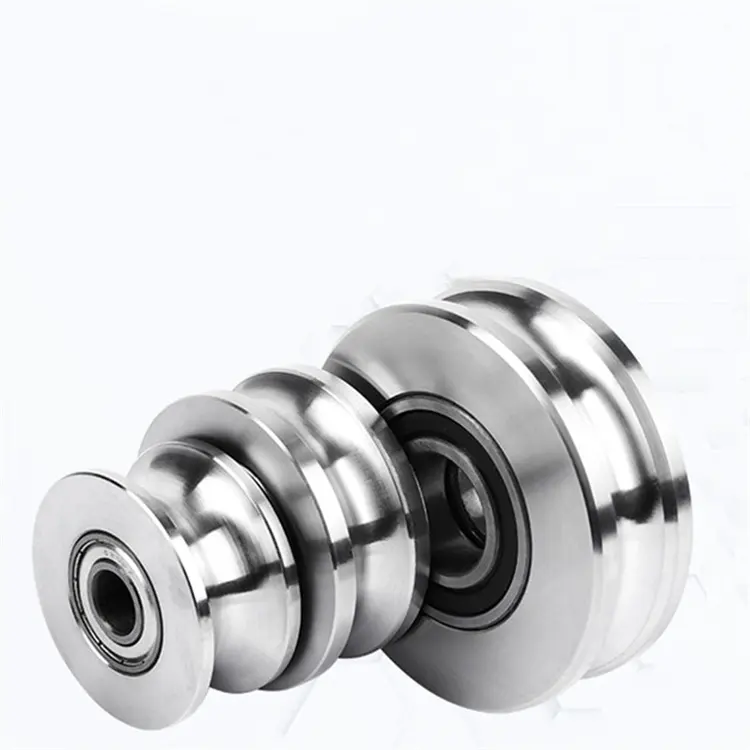
How do fixed pulleys contribute to the efficiency and safety of lifting operations?
Fixed pulleys play a crucial role in enhancing the efficiency and safety of lifting operations. Here’s a detailed explanation of how fixed pulleys contribute to these aspects:
- Mechanical Advantage: Fixed pulleys provide a mechanical advantage, allowing users to lift heavy loads with reduced effort. By redirecting the force applied to the rope or cable, fixed pulleys multiply the input force, making it easier to lift or move heavy objects. This mechanical advantage increases the efficiency of lifting operations by minimizing the physical exertion required and increasing the overall productivity of the task.
- Load Distribution: Fixed pulleys help distribute the load evenly across the lifting system. When multiple fixed pulleys are used in combination, the load is divided proportionally among them, reducing the strain on individual components. This load distribution not only improves the efficiency of the lifting operation but also enhances the safety by preventing overloading of any particular component, minimizing the risk of equipment failure or accidents.
- Control and Precision: Fixed pulleys offer better control and precision during lifting operations. The pulley system allows operators to apply force at a convenient location, while the load is being lifted or moved at a different position. This separation between the input force and the load enables operators to have better visibility and control over the lifting process, enhancing safety and minimizing the chances of accidental damage or injury.
- Force Direction: Fixed pulleys change the direction of force, allowing users to lift or move loads vertically, horizontally, or at different angles. This versatility in force direction contributes to the efficiency of lifting operations by accommodating various spatial requirements. It enables objects to be lifted or moved in the desired direction, optimizing workflow and reducing the need for manual repositioning, thereby saving time and effort.
- Reduced Risk of Back Injuries: By utilizing fixed pulleys, lifting operations can significantly reduce the risk of back injuries. The mechanical advantage provided by the pulley system minimizes the amount of force required to lift heavy objects manually. This reduces the strain on the operator’s back and musculoskeletal system, mitigating the risk of overexertion or back-related injuries, and promoting a safer working environment.
- Safe Load Handling: Fixed pulleys enable safe and controlled handling of loads. The mechanical advantage and improved control offered by the pulley system allow operators to lift or lower loads at a controlled speed, reducing the likelihood of sudden shifts or drops. This ensures that the load remains stable during the lifting operation, minimizing the risk of accidents, collisions, or damage to the load or surrounding infrastructure.
In summary, fixed pulleys contribute to the efficiency and safety of lifting operations through the provision of mechanical advantage, even load distribution, enhanced control and precision, versatile force direction, reduced risk of back injuries, and safe load handling. By utilizing fixed pulleys, lifting tasks can be performed with greater ease, productivity, and safety, improving overall operational efficiency and minimizing the potential for workplace accidents or injuries.

What is a fixed pulley, and how is it used in mechanical systems?
A fixed pulley is a type of pulley that is stationary and does not move. It consists of a grooved wheel mounted on a fixed axle or support. Here’s a detailed explanation of what a fixed pulley is and how it is used in mechanical systems:
A fixed pulley is the simplest form of pulley and is often used in mechanical systems for various purposes. Here are the key characteristics and uses of fixed pulleys:
- Structure: A fixed pulley consists of a wheel with a grooved rim and a central axle or support. The wheel is designed to rotate freely around the axle or support. The groove in the rim accommodates a rope, cable, or belt, allowing it to move along the circumference of the wheel.
- Function: The primary function of a fixed pulley is to change the direction of a force applied to the rope or cable. When a force is applied downward on one side of the rope, the fixed pulley redirects the force upward on the other side. It does not provide any mechanical advantage or change the magnitude of the force.
- Usage: Fixed pulleys are commonly used in mechanical systems for various purposes, including:
- Lifting and lowering loads: Fixed pulleys are often used in lifting systems to change the direction of the force applied to the load. For example, in a block and tackle arrangement, multiple fixed pulleys can be combined with movable pulleys to create a mechanical advantage and facilitate the lifting of heavy loads.
- Tensioning and guiding: Fixed pulleys are used to maintain tension in belts or ropes and guide them along a desired path. They help prevent slack or excessive movement in the system and ensure smooth operation.
- Transferring power: Fixed pulleys are used in power transmission systems, such as in engines or machinery. They guide and redirect belts or ropes to transfer rotational motion or power from one component to another.
- Creating force multipliers: While a single fixed pulley does not provide a mechanical advantage, it can be combined with other pulleys, such as movable pulleys or compound pulley systems, to create force multipliers and increase the mechanical advantage in lifting or pulling applications.
- Advantages: Fixed pulleys offer several advantages in mechanical systems, including their simplicity, ease of installation, and low maintenance requirements. They are often cost-effective solutions for changing the direction of forces or guiding ropes or belts in various applications.
- Limitations: Fixed pulleys have limitations in terms of not providing any mechanical advantage to the force applied. They do not reduce the effort required to lift or move a load. To achieve a mechanical advantage, fixed pulleys need to be combined with other pulleys in a system.
In summary, a fixed pulley is a stationary pulley that changes the direction of a force applied to a rope or cable. It is used in mechanical systems for lifting, tensioning, power transmission, and force multiplication purposes. Fixed pulleys offer simplicity, easy installation, and low maintenance, but they do not provide a mechanical advantage on their own. To achieve a mechanical advantage, fixed pulleys can be combined with other pulleys in various configurations.


editor by CX
2024-03-06

